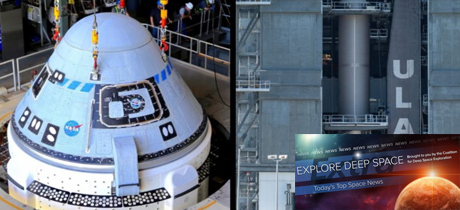In Today’s Deep Space Extra… Boeing’s Starliner has been stacked atop its launch vehicle, a ULA Atlas V rocket, ahead of Orbital Flight Test-2. Artemis I gets help from previous space shuttle veterans ahead of integrated simulation.
Human Space Exploration
Starliner stacked atop rocket for launch of Boeing’s 2nd Orbital Flight Test July 30
Coalition Members in the News – Boeing, United Launch Alliance
Americaspace.com (7/18): The Boeing CST-100 Starliner spacecraft assigned to Orbital Flight Test-2 (OFT-2) has been stacked atop its Atlas V launch vehicle at Cape Canaveral Space Force Station, Florida. Launch is planned for July 30. The uncrewed Starliner will make a second attempt to reach the International Space Station (ISS) for an automated docking, moving it closer to NASA certification for the regular transportation of astronauts to and from the ISS.
Shuttle firing room veterans preparing to help launch Artemis 1
Coalition Members in the News – Boeing, Jacobs, United Launch Alliance
NASAspaceflight.com (7/17): July 8, 2011, marked the final launch of NASA’s space shuttle program from the Kennedy Space Center (KSC) in Florida. The 10th anniversary of the launch earlier this month provided an opportunity for Launch Control Center personnel to participate in an integrated simulation of major launch day activities for Artemis I, the first test launch of NASA’s Space Launch System (SLS) rocket and an uncrewed Orion capsule. Some of the participants were shuttle veterans who will bring the benefits of their experience to the history making liftoff planned for late this year.
Space Science
Hubble returns to normal operations after switch to backup computer
SpaceNews.com (7/17): NASA announced Saturday that the Hubble Space Telescope, launched in 1990, was returning to science operations, following an issue with the payload computer that controls the science instruments. The malfunction occurred on June 13. Despite the recent problems, astronomers remain optimistic that Hubble will continue to operate for years to come. At a meeting of the American Astronomical Society in early June, before this latest issue, officials with the Space Telescope Science Institute said they were working to extend the life of the telescope to as late as 2030.
Other News
China launches secretive suborbital vehicle for reusable space transportation system
SpaceNews.com (7/16): China conducted a clandestine first test flight of a reusable suborbital vehicle Friday as a part of the development of a reusable space transportation system. The vehicle launched from the Jiuquan Satellite Launch Center Friday and later landed at Alxa League in Inner Mongolia Autonomous Region, the China Aerospace Science and Technology Corp. (CASC) announced. The test follows a September 2020 test flight of a “reusable experimental spacecraft.” The spacecraft orbited for days, releasing a small transmitting payload and later deorbited and landed horizontally. The spacecraft is widely believed to be a reusable spaceplane concept, though no images have emerged.
Centennial of ex-astronaut, U.S. Senator John Glenn marked
The Times-Gazette (7/18): John Glenn was honored over the weekend with a three-day festival in Ohio, his state of birth, marking what would have been the history-making astronaut and U.S. senator’s 100th birthday. Glenn, who died in 2016, was the first American to orbit Earth. Before that, he served as a military fighter pilot in World War II and the Korean War and set a transcontinental air speed record. In 1998, he went to space again at age 77. He spent 24 years as a Democrat in the U.S. Senate.
Major Space Related Activities for the Week
Major space related activities for the week of July 18-24, 2021
Coalition Member in the News – Boeing
Spacepolicyonline.com (7/18): The launch of Blue Origin’s New Shepard rocket from West Texas is planned for Tuesday at 9 a.m. EDT. The launch includes the youngest and oldest travelers to fly to space. Early Wednesday, four International Space Station (ISS) astronauts will move their Crew Dragon-2 spacecraft from the forward port of the ISS’s U.S. segment Harmony module to Harmony’s zenith port. That will open the forward port for the arrival of Boeing’s CST-100 Starliner, which is scheduled to launch on July 30. Also on Wednesday, Russia plans to launch its Nauka Multipurpose Laboratory Module to the ISS at 10:54 a.m. EDT. On Friday at 9:17 a.m. EDT, Russia’s Progress 77 cargo capsule is set to undock from the ISS’s Russian segment, taking with it the almost 20-year-old Russian Pirs docking module and airlock to provide a docking port for Nauka. Both the launch of Nauka and the Progress/Pirs departure will be televised on NASA TV and streamed at www.nasa.gov/nasalive. Also Wednesday at 1:00 p.m. EDT, NASA will host a news briefing on the early science results from the Perseverance Mars rover. It, too, will be broadcast on NASA TV and streamed on www.nasa.gov/nasalive. On Thursday, July 22 at 10:00 a.m. EDT, the Space and Science Subcommittee of the Senate Commerce Committee will hold a hearing on “Space Situational Awareness, Space Traffic Management, and Orbital Debris: Examining Solutions for Emerging Threats.”

